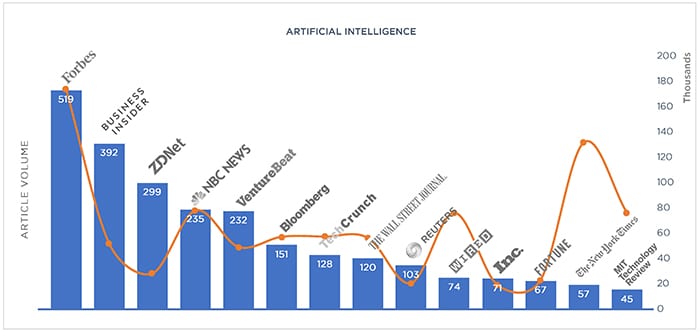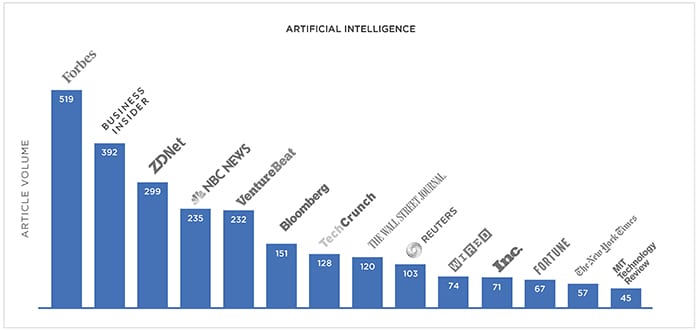
I don’t know how many times I’ve heard, “We must get coverage in The New York Times.” It’s a common denominator for many companies, including technology firms in Silicon Valley. It seems like every RFP you read asks for the same kind of coverage.
I get it. If you work in PR, you know how hard it is to get coverage in the Times, or similar top-tier publications with a huge business reach. It’s the holy grail of media relations and it’s great for bragging rights. The sales teams love it. The CEO proudly showcases the hard copy on her desk or in the company lobby. And a screenshot of the coverage always looks fabulous on a PowerPoint slide highlighting the millions of impressions earned.
But getting coverage in the Times just because it’s the Times isn’t a strategy–it’s one of many outcomes of a successful media relations program.
So, go ahead, have a PR pro pitch the Times–there’s obviously plenty of value in doing so. But looking at data can help you find other ways to get the coverage you’re seeking.
An Approach Using Data
Let’s look at the topic of artificial intelligence (AI), for example. It’s a major topic of discussion within the tech circles of Silicon Valley. Many companies are trying to associate themselves with the term or using AI for product innovation.
Below is an analysis of traditional media to identify the publications driving the AI narrative forward. The analysis spanned 11 months (1/1/18 to 11/18/2018). It looked specifically at AI coverage in the U.S., in English, within the business, technology and software sectors. All coverage that featured AI in either the headline or sub-headline was collected. In all, 44,654 articles were published during this time frame.
The second chart below (without the orange line) reflects the top media publications writing about AI based on volume. For example, since January 1st, Forbes has published 519 articles about AI, Business Insider has published 392 articles about AI, and so on.


Things Are Not Always as They Appear
At first glance, one obvious insight is that Forbes has published the highest volume of AI articles. It should be more receptive to a pitch or a byline.
But these numbers can also be deceiving. Forbes has a fairly large contributor network. It has several councils (e.g. Forbes Tech Council), an invite-only community for the C-suite, consultants and other business professionals. One perk of being part of a council is the ability to publish content on Forbes.com about any relevant topic.
It may also seem a bit discouraging since the Times has written 57 articles on the subject. This might suggest that it is less receptive to a pitch or a byline.
Adding another data point, as the orange line on the top graph indicates, and we can start to see additional insights. These may inform a different direction. For example, you could cross-reference the total article volume from each publication with total interactions. An interaction is a share, like, retweet, comment or an inbound link (a third-party website linking to the article). Basically, it’s an indicator of resonance. The higher the number of interactions, the more the article resonated with the audience.
Forbes is not only leading in total articles published, but also in total interactions, which makes sense. The more content published often will result in more interactions. Forbes published 519 articles about AI and generated about 180,000 total interactions (an average of 346 interactions per article).
On the other hand, the Times published 57 articles resulting in about 140,000 interactions (an average of 2,456 interactions). So getting coverage in the Times is not only great for front-lobby bragging rights, but it provides business value too.
The data also shows when publications like Bloomberg, TechCrunch, WSJ, WIRED, and MIT Technology Review publish articles about AI, the content resonates with their audiences. It makes sense to shift some of your PR resources. Focus on gaining coverage in these other publications. Platforms like Muckrack or Newswhip can help narrow down which journalists are writing about AI the most. With that information you can formulate your engagement approach accordingly.
But before going all in on executing a program, there are other factors to consider. For example, avoid basing your entire media strategy on a single data set.
- Web Analytics: A historical analysis of what type of coverage and which media publications are driving traffic to your website. From there you can track conversions (sales, downloads) if you have your tags set up properly. You can get this data from Google Analytics or Adobe Analytics.
- Influencer Analytics: A topical influencer analysis will help prioritize which influencers (journalists, contributors, industry experts) you’ll want to pitch and/or engage with. Doing so can help maximize your reach since most influencers share their article contributions in their personal social networks.
- Unique Monthly Visitors: A cursory look at the web traffic these publications get directly from external sources, like organic search or referral traffic from other websites. This data is more difficult to acquire since you don’t own the site, but platforms like SimilarWeb can help give directional insights.
- SEO Visibility: An analysis of the Google search results for the targeted media publications. A manual scan of the results for artificial intelligence today show that Forbes and MIT Technology Review enjoy first-page rankings for the term. Interestingly enough, The Verge ranks even higher under “Top Stories” and they didn’t even make it in the above analysis. There are several keyword analysis tools that can give you this data.
This may seem overwhelming and a lot of work. It is, but the key is to take this data in pieces, prioritize what’s important to you and extract the insights accordingly.
Once you have access to this data, you can get a more complete picture of the landscape and start planning a media relations program that delivers business outcomes instead of merely impressions.
NOTE: This content appeared originally in PRNEWS, April 2019. For subscription information, please visit: https://www.prnewsonline.com/subscribe-now/
Michael Brito is EVP of Zeno Group. Follow him: @Britopian
